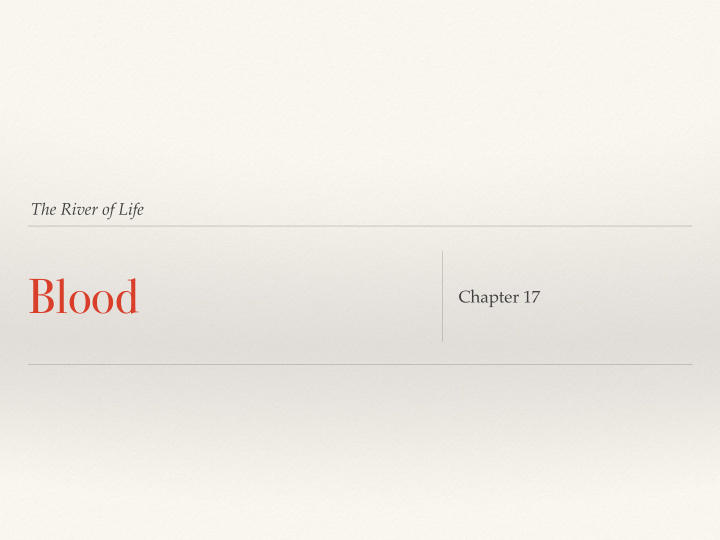



The River of Life Blood Chapter 17
Overview: Blood Composition and Function ❖ Describe the composition and physical characteristics of whole blood. Explain why it is classified as a connective tissue. � ❖ List and describe eight functions of blood.
Blood ❖ The body’s only fluid tissue � ❖ Has both cellular and liquid components � ❖ Highly specialized connective tissue composed of formed elements suspended in fluid matrix called plasma
Components of Blood ❖ Formed Elements � ❖ Erythrocytes (hematocrit): 45% of whole blood � ❖ Leukocytes and platelets: <1% of whole blood � ❖ Plasma 55% of whole blood
Functions ❖ Distribution � ❖ Oxygen, CO2, nutrients, wastes, hormones � ❖ Regulation � ❖ temp, pH, fluid volume � ❖ Protection � ❖ clot formation, antibodie, WBC’s
Blood Plasma ❖ 90% Water � ❖ contains >100 dissolved solutes (nutrients, gases, hormones, wastes, proteins, inorganic ions) � ❖ Albumin comprises 60% of plasma proteins � ❖ Albumin maintains plasma osmotic pressure
Check Your Understanding ❖ What is the Hematocrit? What is its normal value? � ❖ List two protective functions of blood � ❖ Are plasma proteins used as fuel for body cells? Explain your answer.
Formed Elements ❖ Erythrocytes, leukocytes, and platelets � ❖ 2 of 3 are not true cells � ❖ most formed elements survive in the blood for only a few days � ❖ Most blood cells do not divide
Erythrocytes ❖ Describe the structure, function, and production of erythrocytes � ❖ Describe the chemical composition of hemoglobin � ❖ give examples of disorders caused by abnormalities of erythrocytes
Structural Characteristics of Erythrocytes ❖ Biconcave discs = large surface area and easy access to cytoplasm � ❖ anucleate, no organelles � ❖ Highly deformable � ❖ 97% Hemoglobin (Hb) � ❖ generate ATP anaerobically
Functions of Erythrocytes ❖ Gas Transport! � ❖ Hemoglobin � ❖ oxyhemoglobin � ❖ deoxyhemoglobin � ❖ carbaminohemoglobin
Production of Blood Cells ❖ Hematopoiesis � ❖ Occurs in red marrow (100 billion blood cells/day) � ❖ All blood Cells arise from hematopoetic stem cell
Production of Erythrocytes ❖ Stages of Erythropoiesis � � � � � ❖ 15 day process � ❖ Reticulocytes account for 1-2% of erythrocytes in healthy people
Regulations and Requirements for Erythropoiesis ❖ 2 million erythrocytes produced per second � ❖ Process controlled hormonally
Fate and Destruction of Erythrocytes ❖ figure 17.17
Erythrocyte Disorders ❖ Anemia � ❖ blood loss � ❖ not enough cells produced � ❖ too many cells destroyed � ❖ thalassemias � ❖ sickle cell anemia � ❖ Polycythemia � ❖ polycythemia vera � ❖ blood doping
Check Your Understanding ❖ How many molecules of oxygen can each hemoglobin molecule transport? Which part of the hemoglobin molecule binds the oxygen?
Leukocytes (WBC’s) ❖ Goals � ❖ List the classes, structural characteristics, and functions of leukocytes. � ❖ Describe how leukocytes are produced � ❖ Give examples of leukocyte disorders, and explain what goes wrong in each disorder
General Structural and Functional Characteristics ❖ WBC count over 11,000 = leukocytosis � ❖ 2 major categories: � ❖ Granulocytes � ❖ Agranulocytes
Granulocytes ❖ Neutrophils (50-70% of WBC’s) � ❖ Bacteria slayers (phagocytize, respiratory burst, spears) � ❖ Eosinophils (2-4% of WBC’s) � ❖ Primarily attack parasitic worms � ❖ Basophils (.5-1% of WBC’s) � ❖ mediate inflammatory response (release histamine)
Agranulocytes ❖ Lymphocytes (25% of WBC’s) � ❖ very rare in blood � ❖ Monocytes (3-8% of WBC’s) � ❖ differentiate into macrophages once they leave the blood � ❖ macrophages highly phagocytic
Leukocyte Disorders ❖ Leukemias � ❖ Infectious Mononucleosis
Platelets ❖ Fragments of extraordinary large cells (megakaryocytes) � ❖ Essential for the clotting process � ❖ Thrombopoietin
Hemostasis ❖ Step 1: Vascular Spasm � ❖ Step 2: Platelet Plug Formation � ❖ Step 3: Coagulation
Transfusion and Blood Replacement ❖ Goals � ❖ Describe the ABO and Rh blood groups. Explain the basis of transfusion reactions � ❖ Describe fluids used to replace blood volume and the circumstances for their use.
Human Blood Groups ❖ RBC plasma membranes bear highly specific glycoproteins on their external face (antigen) � ❖ Agglutinogens � ❖ 30 groups of antigens, but ABO and Rh are most important
ABO Blood Groups ❖ Based on the presence or absence of two agglutinogens � ❖ Type A, Type B � ❖ Agglutinins � ❖ Type O blood contains anti-a and anti-b agglutinins � ❖ Type A blood contains anti-b agglutins, and vice versa � ❖ Type AB blood contains neither agglutinin (antibodies)
Rh Blood Groups ❖ 52 named Rh Agglutinogens, each called an Rh factor � ❖ Only 3 are common: C, D, and E � ❖ Blood types are labeled as either Rh+ or Rh- � ❖ ABO and Rh reported together. O-, AB+, etc
Blood Groups
Transfusion Reactions ❖ Occurs when mismatched blood is transfused � ❖ recipients agglutinins attack donor blood cells � ❖ Group O = universal donor � ❖ Group AB = universal recipients
Study Guide ❖ www.aandponline.com � ❖ Physiology Tab � ❖ Blood Tab � ❖ Study Guide Link
Recommend
More recommend